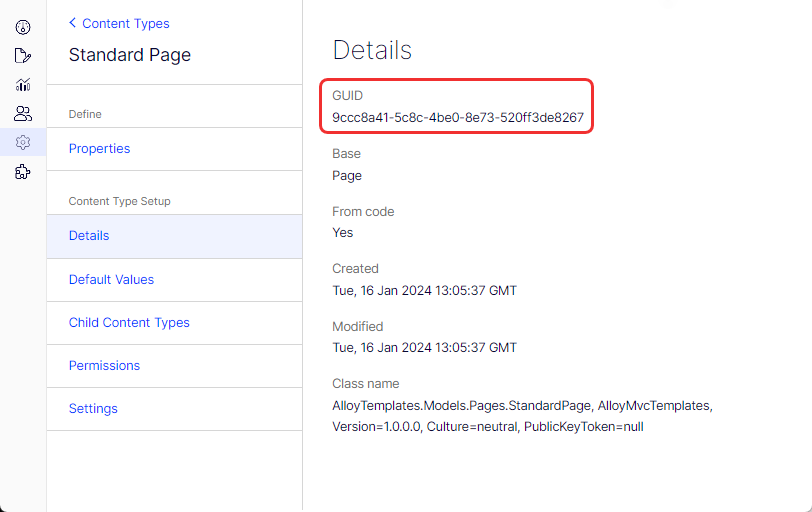Refactor content type classes
Explains how to work with refactoring, when you rename, delete, or change content types in Optimizely.
Rename a content type by GUID
If you specify a GUID in the ContentTypeAttribute and the GUID matches an existing content type, the content type is renamed, and any previous data uses the renamed content type. The admin view displays the GUID of an existing content type when you edit the basic information for a content type.

If you do not specify a GUID in the ContentTypeAttribute of the class when you rename a content type class, you create a content type. If there is no data in the previous content type, it is deleted. However, if pages are created with the previous content type named, the previous page type remains, and the previous pages use the previous content type. When you view the content type in admin view under the Page Type or Block Type tab, the previous content type is marked as missing its code.
Rename a content type by API
When you rename a content type or property using the specific API, create a MigrationStep class with an AddChanges method where you specify the names of the content types or properties to ensure that the existing properties are renamed and retain values they had before They were renamed. The API is based on strings to know the names of previous types and properties.
NoteYou do not need to manually register the
MigrationStepclass, because it will be automatically detected.
The following example shows how to rename a content type and a property on that content type:
using EPiServer.DataAbstraction.Migration;
namespace CodeSamples {
public class MigrationStepExample: MigrationStep {
public override void AddChanges() {
RenameContentType();
RenameProperty();
}
private void RenameContentType() {
//The content type formerly known as "Velocipede" should hereby be known as "Bicycle".
ContentType("Bicycle")
.UsedToBeNamed("Velocipede");
}
private void RenameProperty() {
ContentType("Bicycle") // On the Bicycle content type...
.Property("PneumaticTire") // ...PneumaticTire is an existing property...
.UsedToBeNamed("WoodenTire"); // ...that was previously called WoodenTire.
}
}
}Delete a content type class or property
When you delete a content type or property from the code, the system synchronizes the database as much as possible without deleting data (values saved on any page). The content type or property is deleted from the database if there is no data. If any data is present, the content type or property remains and is marked in the admin view as missing its code.
Delete a culture-specific attribute on a property
When you manually change a property from being culture-specific to not being culture-specific in the admin view, the change may not be reflected on the site when culture-specific data is stored in the database. If this occurs, an error is logged but makes no change to the property in the database.
Change the type of a property
You may want to replace obsolete property types or change property names and property types when you refactor or improve your code.
Before you can change the type of a property (from XhtmlString to String for example), you must meet the following criteria to ensure that a change of type in the code does not lose data.
- The previous or new property type cannot be a block.
- If the new type is
String, then any previous value cannot be longer than 255 characters. - You must be able to set the previous value to the new type, OR you can parse it in the
ParseToSelfmethod of the new types backingPropertyData. - The value of the backing
PropertyDatayou are changing to must implement theSystem.IConvertibleinterface. - The backing
PropertyDataalso must have itsTypeproperty set to any of the seven first values of thePropertyDataTypeenumeration.
If you need a change of type and any data loss is acceptable, you can change the property type in admin mode, but you must temporarily remove the property from the code.
If the conversion of existing data to the new type fails, an error is logged, and nothing is committed.
Changing an obsolete property type to refactor it in code involves several steps to ensure that your application continues to function correctly after the change. Here is a general guide on how to approach this:
- Identify the property – Locate the property in your code, such as one that is marked as obsolete. This is typically indicated by an bsolete] a attribute or a warning from your integrated Development Environment (IDE)
- Decide what the new property type should be – This could be based on updated requirements or the availability of a more suitable type.
- Update the property definition – Change the type of the property in your class definition to the new type. Update any attributes or metadata associated with the property if necessary.
- Refactor use throughout the code base – Search for instances where the property is used and update them to accommodate the new type. This might involve changing method calls, data assignments, or logic that interacts with the property.
- Update related documentation and tests – Ensure any documentation referencing the old property type is updated to reflect the changes. Update or add unit tests to cover the new property type and ensure it behaves as expected.
- Test your application – Thoroughly test your application to ensure that the refactoring does not introduce any bugs or regressions. Pay particular attention to areas of the code that heavily relied on the obsolete property.
- Deprecate or remove the old property – If the old property still exists in your code (perhaps for backward compatibility), consider marking it as obsolete with a warning message for future removal. If it is no longer needed, you can safely remove it after you update its all dependencies.
Updated about 1 month ago